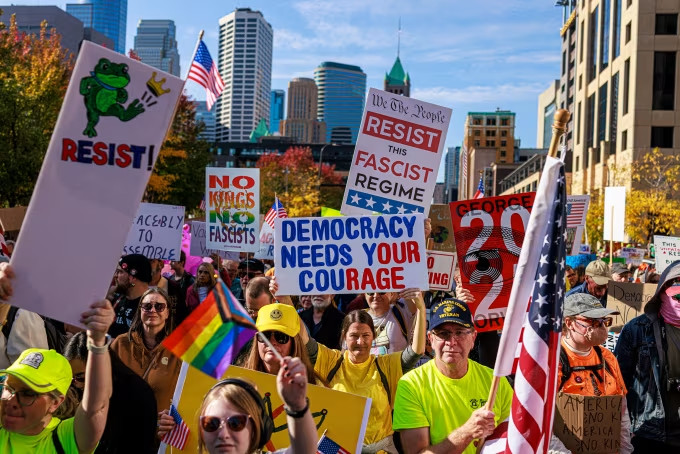WASHINGTON, D.C. — Marking her 70th birthday, retired Michigan government worker Peggy Cole drove nearly 10 hours from Flint to the nation’s capital with a friend — not for celebration, but to protest. For Cole, the moment felt too critical to stay home. “It’s a scary time,” she said. “Trump is dismantling our democracy piece by piece if we don’t stand up.”
Her voice was one among nearly 7 million Americans who joined more than 2,700 “No Kings” demonstrations nationwide on Saturday — a sweeping escalation from similar protests held in June.
Coast-to-Coast Turnout
Organizers reported:
100,000+ protesters in New York City
Rallies in all 50 states
Demonstrations in major cities and small towns alike
Multiple marches in Washington, D.C., Los Angeles, Chicago, Atlanta and Portland
Participants gathered in public squares, parks, and along highways, waving American flags and hoisting signs with slogans opposing authoritarianism, executive overreach and immigration crackdowns.
While the majority of events were peaceful, isolated confrontations were reported. Police in South Carolina arrested a woman accused of brandishing a firearm near a demonstration, and a man in Georgia was caught on video shoving a protester and seizing a flag.
Democracy Front and Center
Many protesters said they were motivated by what they see as growing threats to democratic norms and institutions.
In Atlanta, Georgia Sen. Raphael Warnock addressed a large crowd, declaring, “This is not about the people in power — it’s about the power in the people.” Attendees echoed similar concerns, emphasizing their right to protest without fear.
One New York demonstrator, protesting since the 1960s, said this moment feels different: “Back then, we were expanding rights. Now we’re fighting to keep them from being taken away.”
Some groups adopted themes of historic symbolism. In Washington, D.C., demonstrators dressed in Revolutionary War attire with signs reminding the public that “America was founded with no kings.”
Costumes, Unity Symbols, and Street Theater
Yellow clothing became a unifying visual symbol, meant to reflect nonviolence and collective purpose. Others wore inflatable costumes — chickens, dinosaurs, unicorns and frogs — underscoring the contrast with depictions of the movement as dangerous.
“It’s hard to call this a war zone when it feels like a block party,” said a Los Angeles protester dressed as a unicorn.
Chants like “This is what democracy looks like” and “No hate, no fear, immigrants are welcome here” rang through megaphones in city after city.
Immigration, Federal Power, and Civil Rights
The protests come after a summer marked by mass immigration raids, the deployment of federal agents to Democratic-led cities and escalating legal fights over the use of the National Guard.
In Los Angeles, where earlier ICE raids sparked large demonstrations, protesters demanded an end to deportation campaigns. “We’re all immigrants, and everyone has rights here,” said Maria Rivera Cummings, a Los Angeles native.
In Chicago, a center of resistance to immigration enforcement, crowds carried Mexican flags and signs like “ICE OUT!” and “Hands Off Our Democracy.” Actor John Cusack addressed the crowd, warning that using the military domestically crosses a constitutional line.
Economic Anxiety and Social Programs
Worries about cuts to public services also drew thousands into the streets. With the federal government partially shut down, many protesters voiced fears about looming changes to health care programs like Medicaid.
A furloughed federal worker in Washington called the situation “devastating” for families facing lost jobs and rising prices. Another demonstrator in Baltimore, a hospital social worker, said essential services are at risk as vulnerable patients rely on programs now in jeopardy.
Workers, Unions, and Public Servants
Union members and federal workers turned out in large numbers — many of them affected by the shutdown or criticized by the administration.
Anthony Lee, a 20-year veteran of the Food and Drug Administration and a local union leader, said his motivation was simple: “To see public services dismantled is frightening. We came to stand up for the people we serve.”
Another furloughed worker said federal employees are being “demonized” and stripped of basic job security.
Political Voices Weigh In
Sen. Bernie Sanders spoke at the Washington rally, linking the protests to a broader fight over power and wealth. He accused Trump and allied billionaires — naming Elon Musk, Jeff Bezos and Mark Zuckerberg — of “hijacking the political system.”
“This moment is not just about one man,” Sanders said. “It’s about working families versus the handful of wealthiest people who think they own our democracy.”
‘No Kings’ Movement Gathers Momentum
Organizers behind the “No Kings” movement, including the Indivisible Project and the decentralized group 50501, say the surge in participation reflects alarm across the political spectrum. The groups say more people are seeking nonviolent ways to push back against executive overreach.
Training in safety and de-escalation was emphasized across events after rising political tensions in recent years.
For longtime protest veterans and first-time marchers alike, the message was clear: democracy depends on active participation.
As Peggy Cole put it after arriving in Washington: “If we don’t show up now, when will we?”

